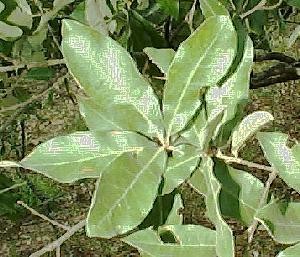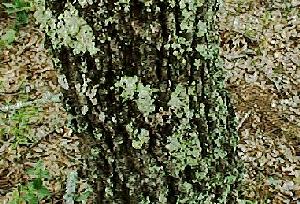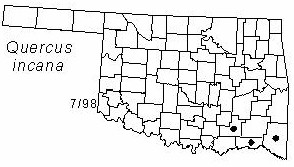

Small tree to 10 m (30 ft) tall and 0.5 m (18 in) diameter, or sometimes a shrub. Bark dark gray, rough, thick, furrowed into nearly square plates. Twigs slender, dark brown, hairy when young, ending in a cluster of glabrous short-pointed brown buds. Leaves alternate, narrowly oblong, not toothed or lobed, tapering to base, 5-10 cm (2-4 in) long and 13-25 mm (0.5-1 in) wide, shiny blue-green above, dull gray-green and finely hairy below. Fruits are acorns maturing in the second year, round, about 15 mm (0.6 in) in diameter, with cup covering about 1/4-1/2.
Distribution: Native on the Coastal Plain in scattered locations from Texas to Virginia.
Habitat: found on sandy soils in scattered locations in southeastern Oklahoma.
NWI status: none
Comment: Bluejack oak is too small and rare to have any commercial use. Quercus is the ancient classical name for the European oaks; incana refers to the finely-hairy grayish-green lower surface of the leaves.
Distribution in Oklahoma: 
BACK
NEXT
RETURN TO INDEX
Last update: 9/16/99
 Go to Oklahoma Biological Survey Home Page
Go to Oklahoma Biological Survey Home Page
 Disclaimer
Disclaimer